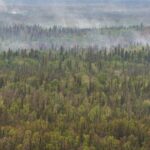A thick blanket of acrid smoke hangs over much of central Manitoba today as emergency crews battle multiple aggressive wildfires that have forced thousands of residents from their homes in what officials are calling an unprecedented early-season evacuation crisis.
The first wave of evacuees arrived in Winnipeg yesterday evening, their faces etched with worry as they stepped off buses at the emergency reception center established at the RBC Convention Centre. Many carried only hastily packed bags, having had mere hours to decide what possessions to bring as flames approached their communities.
“We could see the fire coming over the ridge while we were loading the car,” said Marjorie Redhead, a 63-year-old resident of Cranberry Portage, one of the communities under mandatory evacuation orders. “I’ve lived here my whole life and never seen anything like this happening so early in the year.”
Provincial officials report over 3,500 people have been displaced from five communities in Manitoba’s north-central region, with that number expected to rise as firefighting efforts struggle against unusually dry conditions and shifting winds. The Canadian Red Cross has established operations in Winnipeg, The Pas, and Thompson to provide temporary shelter, food, and essential supplies.
Manitoba’s wildfire service confirmed that at least three major fires have merged into a complex covering more than 42,000 hectares northeast of Flin Flon. Water bombers and ground crews have been deployed, but extreme drought conditions following Manitoba’s driest winter in 15 years have created ideal conditions for rapid fire spread.
Environment Canada has issued air quality advisories for much of central Manitoba, with particulate matter readings reaching “very high risk” levels in several communities. Health officials are warning vulnerable populations, including children, the elderly, and those with respiratory conditions, to remain indoors with windows closed and air purifiers running if available.
“These early-season wildfires represent exactly the pattern climate scientists have been warning about,” explained Dr. Catherine Burnett, an environmental health researcher at the University of Manitoba. “Earlier springs, drier conditions, and more extreme weather events are creating longer and more intense fire seasons across the Canadian boreal forest.”
The provincial government has activated its emergency coordination center and requested additional resources from neighboring provinces. Saskatchewan has already dispatched three additional water bombers and a specialized rapid response team to assist Manitoba’s efforts.
Premier Wab Kinew, who toured the evacuation center yesterday, announced $2.5 million in emergency funding to support displaced residents. “We are mobilizing every resource available to protect Manitobans and their communities,” Kinew stated. “This is a developing situation that may worsen before it improves.”
For residents facing evacuation orders, the Manitoba Emergency Measures Organization has established a 24-hour hotline (1-888-267-8400) for information about evacuation routes, reception centers, and emergency services.
As Manitoba faces what may become one of its most challenging wildfire seasons in recent memory, the question emerges: is this early-season crisis merely an anomaly, or does it represent the new normal for a province increasingly vulnerable to climate change impacts?










